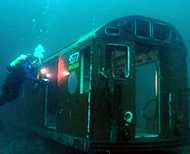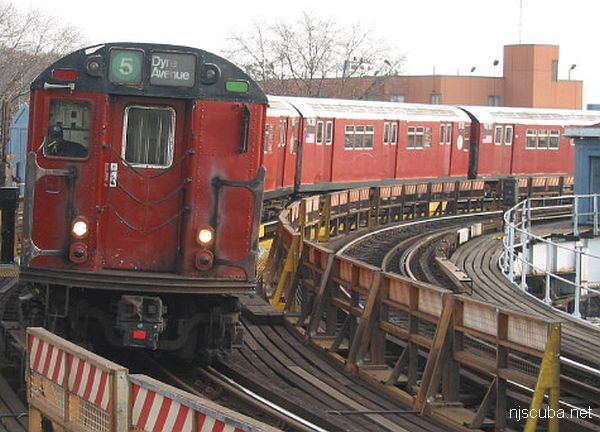Redbird Subway Cars (2/3)
Ristori: Subway cars OK'd, Future Ones Halted
Thursday, April 03, 2003
BY AL RISTORI
Star-Ledger Staff
Two years of controversy and political intrigue over 650 subway cars offered by New York City for placement on the state's artificial reefs at no charge ended yesterday when Department of Environmental Protection Commissioner Bradley Campbell, at a meeting in his Trenton office, accepted the last 250 cars remaining but also imposed an eight-year moratorium on taking any more.
Tom Fote, representing the State Federation of Sportsmen's Clubs, opposed the moratorium as being of no value and nothing more than a political payoff to Clean Ocean Action's Cindy Zipf, who was the individual preventing acceptance of the entire 650 cars originally offered by the New York City Transit Authority to New Jersey. Zipf's first objection was on the basis that the state was making a junkyard of the ocean floor. When that didn't fly, she latched on to the minimal asbestos content in the cars.
Scientific evidence provided by the federal Environmental Protection Agency proved that the asbestos was innocuous, and the project was approved by every federal agency involved, but acting Gov. Donald DiFrancesco still turned down the cars. That was just fine with Delaware, which held public hearings, brought out all the facts, and accepted a multimillion-dollar bonanza for their reefs at New Jersey's expense.
The first 250 cars were lost at that time, but 400 were still available when Gov. James E. McGreevey took office with a commitment to revisit the issue. In the meantime, Georgia, South Carolina, and Virginia were also eagerly snapping up whatever cars they could obtain. It was only due to the goodwill of the transit agency's David Ross that these last 250 were held for New Jersey.
Having already lost millions of dollars worth of free reef material involved in 400 subway cars, Fote and other sportfishing and diving leaders objected to the imposition of the eight-year moratorium, which will prevent the state from accepting any other subway cars that may become available during that period.
While everything so far has been done behind closed doors, Campbell did promise to hold public hearings on his Policy Directive 2003-02, which sets new artificial reef standards -- including the moratorium and doubling the structural integrity of materials from 15 to 30 years.
EPA regional oceanographer William Muir has estimated that the subway cars will last 25 to 30 years. That's based on his observations of Philadelphia subway cars with thinner walls that were sunk in 1990 and are still in good shape. Furthermore, in a letter to Zipf I unearthed yesterday, Muir noted that adding zincs "would double or triple the normal life of the car from corrosion but would need to be replaced every year. This is not at all out of the realm of the sport diving community."
Though Muir answered all of Zipf's objections, his opinions were downplayed at the meeting despite his background of having made more than 1,000 dives on natural and artificial reefs over the last 35 years and being the EPA's marine pollution expert since 1988.
Someone questioned the cost of the zincs, but that would be small change in an otherwise completely free deal -- especially when compared with the $90,000 required for a single barge load of concrete shapes, which anglers were trying to raise at last night's meeting in Brick sponsored by the Greater Point Pleasant Charter Boat Association. There are lots of free materials for reefs, but it's rare when fishermen and divers don't have to raise large sums for cleaning, transportation, and placement.
While it's a shame one person was able to deprive the state's artificial reefs of 400 subway cars at no cost, at least there should be 250 placed on five reef sites by late summer or early fall -- and the public will be able to express disapproval of changes made to the Artificial Reef Standards.
Al Ristori appears regularly in The Star-Ledger.
With a Splash, Ocean Creatures Get a New Home
Subway Cars dumped into water for artificial reef
By KIRK MOORE
STAFF WRITER
During four decades on the subterranean rails of New York City, car 9577 must have seen its share of daily drudgery and dramas. But no matter how tense it got, the subway car's riders never ate each other.
That's about to change. Yesterday, dive boat captain Steven D. Nagiewicz poked his digital camera into an open door on the now-sunken coach and recorded its first ocean visitors -- a floating red jellyfish and a school of swarming bergalls, small fish that live on the reef, forerunners of the wild community that will soon colonize 50 retired subway cars on what is called the Shark River Reef.

"In a couple of weeks, there will be marine life all over them. In a few months, they'll be completely covered, " Nagiewicz said after surfacing from a brief exploration. "This particular spot will be very interesting for dives."
The last of 250 cars donated by the Metropolitan Transit Authority to New Jersey's artificial fishing reef program splashed off a barge almost 16 miles east of the Shark River and Manasquan inlets yesterday. The cars were deposited after a controversy that pitted fishermen and reef supporters against their usual allies in the environmental movement, who contended that dropping subway cars into the water crossed the line into ocean dumping.
This fall, a committee of marine scientists will discuss the best way to monitor the subway cars' performance as artificial reef material and how to assess the future of such novel reef-building. Since 1984, efforts at 14 reef sites along the coast have shown it's possible to create enough new hard surfaces to attract small marine life and the larger fish that feed on it, thus increasing the number of fish that anglers catch, according to state Division of Fish and Wildlife officials.
"All you have to do is find a recreational fisherman to tell you what the benefits are. There's no question about that, " said Dennis Suszkowski, science director for the Hudson River Foundation, and a Freehold resident who is one expert recruited to the reef committee. What's more difficult is estimating "how stable the cars are over time, " Suszkowski said. "I suppose that will be the big question."
Critics of using subway cars for reefs pointed to asbestos in floor tiles and fireproofing on the cars, which were manufactured in the 1960s before cancer dangers led industries to stop using the mineral fiber. Reef advocates countered that while airborne asbestos fibers pose a danger, there's little environmental threat underwater. Nagiewicz counts himself among those who think the cars are safe.
"I never understood what the hubbub was about over the cars, " Nagiewicz said as he steered his charter boat Diversion II toward the Shark River Reef. Compared to more than 100 cleaned-up old ships, tugs, and barges purposefully sunk on reefs, there are 2,000 to 3,000 shipwrecks littering the seafloor off New Jersey, he said. Some of those are 20th-century ships, most likely with lots of asbestos insulation on their pipes, lost to submarine warfare, collision, and accidents, he said.
"This whole seafloor is nothing but sand and a few rock outcrops, from here out to the canyons" at the edge of the continental shelf, Nagiewicz said. "Not that I'm advocating dumping stuff all over, but the wrecks and the reefs are the only oases."
To quell worries that subway cars might break up and produce debris, a compromise brokered by state environmental Commissioner Bradley M. Campbell accepted the cars for use at five relatively deep-water reef sites; Shark River and the Garden State North Reef east of Harvey Cedars are the last two sites to get cars.

At the Shark River site, the cars join an array of old ships that include cleaned-up oil tankers and retired Navy vessels. "One of the ships out here, the Algol, cost $500,000 to clean and get all the PCBs ( polychlorinated biphenyls ) out. They got it for free, but it costs money to get it clean, " Nagiewicz said.
Landside disposal costs inspired New York transit officials to give away more than 1,000 cars, called Redbirds for their distinctive paint, to South Carolina, Delaware, Georgia, Virginia, and New Jersey. Even after paying barging costs, the MTA has saved an estimated $17 million it would have cost to remove asbestos and scrap the cars on land.
With clangs and screeches of steel, Weeks Marine employees toppled each car onto the reef yesterday. Most sank in about 130 feet of water, but some were emplaced on "The Rockpile, " where rock dredged from harbor shipping channels has raised the bottom by 30 feet or more, the divers said.
Sparrows and other small birds, rousted from hiding spots in the subway cars, fluttered to the Diversion II for refuge. They perched on rails and even hopped into the cabin, as Nagiewicz and crewman Richard Galiano of Matawan suited up for their dive.
Nagiewicz volunteered his boat for this mission, to help state reef coordinator William Figley check out how the cars had landed on the seafloor. The divers said cars on the rockpile depths might interest recreational scuba enthusiasts, who usually prefer stark and spooky shipwrecks.
"Most people would not want to dive 130 feet unless they are going to see a ship, " Galiano explained. "But in 50 feet of water, these subway cars can become attractive."
Asbury Park Press
10/15/03

